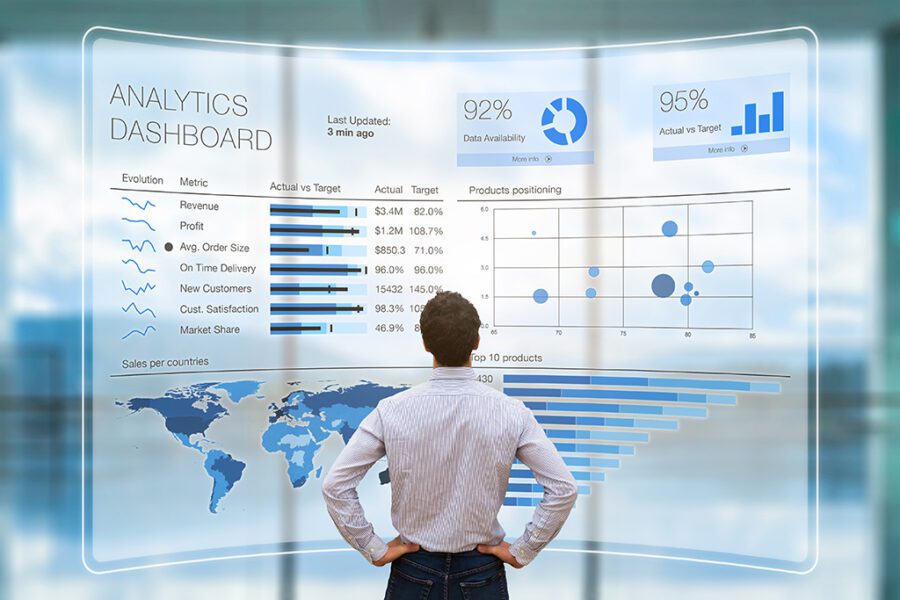In the modern business landscape data is an essential asset that can make or break an enterprise. Power BI, Microsoft Fabric and other powerful tools are employed by companies to unlock the full potential of their data. These platforms form the backbone of business analytics, and when combined with Azure Data Factory become an unstoppable force.
Power BI: Your Business Intelligence Companion
Power BI is an application for business intelligence by Microsoft that helps organizations visualize their data and share insights. It allows users to design interactive reports and dashboards, transforming raw data into actionable information.

Power BI can be tailored to meet your individual needs whether you’re a startup or a large business. It connects to multiple sources of data to make it easier for users to consolidate data from different platforms and databases. Even non-technical users can use it to quickly create meaningful reports and analyze data using its easy drag-and drop interface.
Power BI supports real-time processing of data, making sure that you are always armed with the most current information. Power BI offers a range of visualizations to help you present information in a compelling and digestible format. Collaboration and sharing reports with colleagues can improve decision-making and encourages a data-driven culture in your organization.
Microsoft Fabric The weaving of data Excellence
Microsoft Fabric is the core system that connects and coordinates data across a variety of Microsoft services. Fabric is the thread that ties your data into an encapsulated, usable entity, enabling businesses to derive insights seamlessly.
Microsoft Fabric helps businesses maintain data integrity and consistency as they handle increasing numbers of data. Microsoft Fabric integrates a variety of tools, such as Azure Data Lake Storage (Azure SQL Data Warehouse), Power BI, and more. The interconnectedness of the platform allows data flow and insight coming from a variety of sources.
Microsoft Fabric’s data transformation capabilities are a great example of its versatility. Utilize it to tidy up and prepare data for analysis. You can also use it to ensure that your data is compliant to your company’s guidelines for data governance. Microsoft Fabric is the platform that will ensure your data is reliable precise, reliable, and prepared for analysis.
Azure Data Factory: The Gateway to Data Transformation
Azure Data Factory is another essential component in the modern business intelligence landscape. It is a cloud-based solution that allows you to manage and plan data-driven processes. Azure Data Factory provides meaningful insights by orchestrating data movement and transformation.
Azure Data Factory’s ability to connecting to various data sources is among its major advantages. No matter if your data is located on-premises or in the cloud, it can be integrated seamlessly so that you can have an entire view of your entire data ecosystem. The platform is able to handle batch processing as well as real-time data streams as well as analytics based on big data, making it a good fit to a range of use cases.
Azure Data Factory has a visual user interface that simplifies developing data pipelines. It is easy to create, schedule, and monitor data workflows even if you’re not a coder. This lets users stay in control of data integration and self-service data preparation.
Power BI, Microsoft Fabric and Azure Data Factory: The Power Trio
When Power BI, Microsoft Fabric, and Azure Data Factory come together in a dynamo trio that can transform your data analytics activities. These three technologies can work in synergy:
1. Data Integration: Azure Data Factory connects to a myriad of data sources, ensuring that your data is accessible. The data integration feature feeds into Microsoft Fabric, which orchestrates data across a variety of services. This ensures that the data you have properly structured cleaned and arranged to be analysed in Power BI.
2. Data Transformation: Microsoft Fabric plays a essential role in data transformation and allows you to tailor your data to meet your requirements for analytical analysis. When it comes to data manipulation, cleaning, or even transforming, the fabric ensures that the data is in good shape for meaningful insights.
3. Power BI will take over when your data has been refined and is ready to be used. It allows you to create visually appealing reports and dashboards, which make complex data simpler to comprehend. You can then present these findings and inspire your team to make decision-based on data.
4. Scalability: Azure Data Factory can expand to handle growing data volumes. Combining Power BI with Microsoft Fabric will guarantee that your data will remain stable and reliable even as your business grows.
5. Power BI & Azure Data Factory offer real-time data that is vital to agile decision making.
The conclusion of the article is:
The world of business intelligence is rapidly changing and organizations must harness the power of data in order to remain competitive. Power BI, Microsoft Fabric and Azure Data Factory are a powerful trio that can help you take your business intelligence to new heights. This trio can help you achieve amazing visualizations as well as improve consistency of data and streamline workflows. Explore the full potential of data by utilizing business intelligence.
Leave a Reply